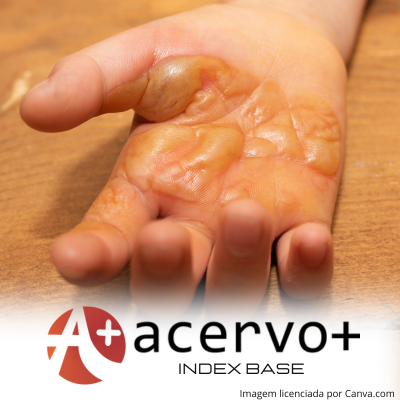Desafios e implicações das abordagens personalizadas no planejamento e execução de enxertos de pele na recuperação de pacientes com queimaduras severas
##plugins.themes.bootstrap3.article.main##
Resumo
Objetivo: Explorar e analisar as evidências sobre as abordagens personalizadas no planejamento e execução dos enxertos de pele em pacientes com queimaduras severas, com o intuito de identificar os principais fatores que influenciam na recuperação dos pacientes e sua qualidade de vida. Métodos: Este estudo é uma revisão bibliográfica integrativa, conduzida seguindo a estratégia PVO. Foram realizadas buscas na base de dados PubMed Central (PMC) usando termos específicos, resultando em 529 artigos. Após a aplicação dos critérios de inclusão – artigos dos últimos 5 anos relacionados ao tema – 13 artigos foram selecionados. Resultados: O tratamento de queimaduras avançou com o uso de enxertos autólogos, substitutos dérmicos, terapias celulares e curativos biossintéticos. Essas abordagens melhoram a cicatrização, reduzem dor, cicatrizes e tempo de internação. A terapia por pressão negativa e técnicas como “cover-to-close” também mostraram bons resultados. Estudos futuros são necessários para padronizar indicações e validar a eficácia clínica. Considerações finais: São necessárias futuras investigações e contínua atualização dos profissionais para melhorar a qualidade de vida dos pacientes com queimaduras severas.
##plugins.themes.bootstrap3.article.details##
Copyright © | Todos os direitos reservados.
A revista detém os direitos autorais exclusivos de publicação deste artigo nos termos da lei 9610/98.
Reprodução parcial
É livre o uso de partes do texto, figuras e questionário do artigo, sendo obrigatória a citação dos autores e revista.
Reprodução total
É expressamente proibida, devendo ser autorizada pela revista.
Referências
2. BURGESS M, et al. The Immune and Regenerative Response to Burn Injury. Cells, 2022; 11: 3073.
3. CRETU A, et al. Strategies for Optimizing Acute Burn Wound Therapy: A Comprehensive Review. Medicina, 2025; 61, 128.
4. DAGHER J, et al. The Self-Assembled Skin Substitute History: Successes, Challenges, and Current Treatment Indications. Journal of Burn Care & Research, 2023; 44: 57-64.
5. FAOUR S, et al. Fibrosis in burns: an overview of mechanisms and therapies. Am J Physiol Cell Physiol, 2023; 325: C1545–C1557.
6. JIANG ZY, et al. Negative-pressure wound therapy in skin grafts: A systematic review and meta-analysis ofrandomized controlled trials. Elsevier Ltd and ISBI, 2021, 47: 747-755.
7. KIM H, et al. Review of History of Basic Principles of Burn Wound Management. Medicina, 2022; 58: 400.
8. MASON SA, PHAM TN. Use of Dermal Regenerative Templates for Burns. Journal of Burn Care & Research, 2023; 44: 19-25.
9. OZHATHIL DK, et al. A Narrative Review of the History of Skin Grafting in Burn Care. Medicina, 2021; 57: 380.
10. PEDRAZZI NE, et al. Negative Pressure Wound Therapy in Pediatric Burn Patients: A Systematic Review. Advances in wound care, 2021; 40: 270-280.
11. RADZIKOSKA-BUCHNER E, et al. An Overview of Recent Developments in the Management of Burn Injuries. Int. J. Mol. Sci., 2023; 24: 16357.
12. RAHIMI F, et al. Use of a biosynthetic wound dressing to treat burns: a systematic review. Journal of Wound Care, 2020; Vol 29, NO12: 16-22.
13. SCHLOTTMANN F, et al. A Short History of Skin Grafting in Burns: From the Gold Standard of Autologous Skin Grafting to the Possibilities of Allogeneic Skin Grafting with Immunomodulatory Approaches. Medicina, 2021; 57: 225.
14. SUCA H, et al. Current Approaches to Wound Repair in Burns:How far Have we Come From Cover to Close? A Narrative Review. Journal of Surgical Research, 2024; 296:383-403.
15. VAN DEN BOSCH AS, et al. Outcomes of dermal substitutes in burns and burn scar reconstruction: A systematic review and meta-analysis. Wound Repair and Regeneration, 2024; 32:960–978
16. VAN DEN BOSH AS, et al. Indications for the use of dermal substitutes in patients with acute burns and in reconstructive surgery after burns: A systematic review. Wound Repare and Regeneration, 2025; 33:e13248.
17. WORMALD JCR, et al. Hydrosurgical debridement versus conventional surgical debridement for acute partial-thickness burns (Review). Cochrane Database of Systematic Reviews, 2020; Issue 9. Art. No.: CD012826.
18. WONG L, et al. Systematic review of excision and grafting in burns: Comparing outcomes of early and late surgery inlow and high-income countries. Burns, 2021; JBUR 6472.
19. YASSAGHI Y, et al. Advancements in cell-based therapies for thermal burn wounds: a comprehensive systematic review of clinical trials outcomes. Stem Cell Research & Therapy, 2024; 15:277.
20. ZWIERELLO W, et al. Burns: Classification, Pathophysiology, and Treatment: A Review. Int. J. Mol. Sci, 2023; 24, 3749.

